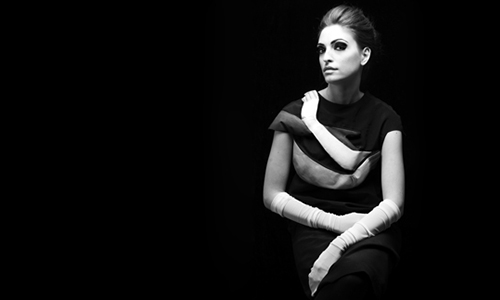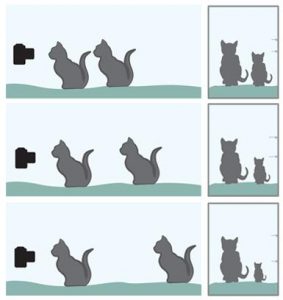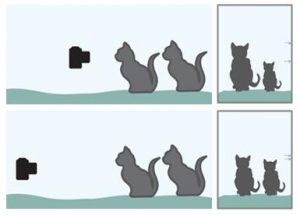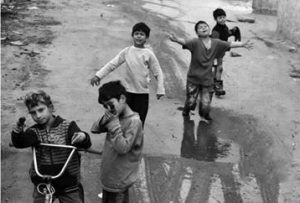Size
Size ratio is a very important element in photography for understanding the balance of the composition.
Balance implies that the visual elements within have a sense of weight. Large objects generally weigh more than small objects and dark objects weigh more than light colored objects. The position of the elements is also important. Unconsciously we assume that the center of an image corresponds to a point of pressure. A heavy weight on one side can be balanced by a lighter weight on the other if the lighter weight is located at a greater distance from the point of pressure. Similar example is a seesaw in a park – a heavier child should be closer to the center of gravity, the lighter one should be placed a bit farther in the seesaw, so that the weight would be evenly distributed.

Positive space is where forms exist. It is the area in the picture occupied by the object. A negative space is empty space around shapes, objects, and it surrounds our center of interest. Areas of an image that contain “nothing” are important visual elements that balance in an image. Actually, if well used, the negative space becomes the subject, and brings its message and the atmosphere in photography. The negative space provides balance in a photograph and also occupies a place for eyes to relax, a neutral or contrasting background drawing attention to the main subject, which then is referred to as the positive space. A cluttered background tends to diminish the importance of the subject, while a plain background draws attention to it. The effective placement of objects in relation to the negative space around, is essential for success in the composition. Negative space can give photograph an entirely different atmosphere than the other photograph of the same subject. The absence of content does not mean the absence of interest. In fact, negative space often adds interest as it can place a stronger emphasis on the subject and it can evoke emotions effectively.

With keeping the same place of shooting, but along with changing mutual distance between objects, the ratio to their weight comparing each other (meaning: mutual size of objects) in the picture will vary.
 The size of the object in the image varies with the inverse of the distance. For example, we have two objects, say cats, which are away from the camera for example, 1 meter and 2 meters, the other cat, which is at distance of 2 meters, is twice as far as the first cat and will, therefore, seem to be twice smaller on picture.
The size of the object in the image varies with the inverse of the distance. For example, we have two objects, say cats, which are away from the camera for example, 1 meter and 2 meters, the other cat, which is at distance of 2 meters, is twice as far as the first cat and will, therefore, seem to be twice smaller on picture.
If the other cat would be distanced 3 meters form the camera, its size would be three times smaller in the picture, in relation to the cat that 1 meter away. We see that if the distance increases in the ratios of 1: 2 and 1:3, the size decreases, the ratio of 2:1 and 3:1.
This relationship is retained, so the cats that are within 1 and 4 meters, will be in the ratio of 4:1, ie, the closer one will be 4 times higher than the one further away. This is a very important relationship that should be remembered and used when shooting.
With keeping mutual distance between objects with each other, but along with approaching or moving away from the scene, the ratio the weight of objects comparing to each other (meaning: mutual size of objects) in the picture will vary.
 On the other hand, when we set objects to shoot, the space that we determine for the placement of objects can significantly affect the perspective. When photographing objects that can not be moved, we can change the perspective by moving away from the object, but then mutual relations begin to change.
On the other hand, when we set objects to shoot, the space that we determine for the placement of objects can significantly affect the perspective. When photographing objects that can not be moved, we can change the perspective by moving away from the object, but then mutual relations begin to change.
Consider again the example of our cats, the first is at the distance of 1, and the other 2 meters away, their size in picture 2 are in ration 2:1. If we move away from the first cat at the distance of 2 meters, the other is 3 meters away from us. We see that the relationship has changed considerably, their size in the picture no longer applies as 2:1 rather than 3:2.
Aspects of balance
There are many factors to consider to make pictures appear balanced. Some of these are:
An object farther from the center of the image seems to have more weight than the one near the center.
Objects in the upper part of the image seems heavier than objects of the same size in the lower part of the image.
Isolation seems to increase the weight of an object.
Intensely interesting objects seem to have more weight in the composition.
Regular forms seem to have more weight than irregular shapes.
Elements on the right side of the asymmetrical image appear more heavy than elements of the same size on the left side of the image.
Directions in which figures, lines and shapes seem to move in the image are important for balance, for example, a person can walk in one direction, or maybe his eyes look in one direction or shape of some element creates a sense of the movement. When the sense of direction is in a scene, it tends to disrupt the balance.
Here is an example. Look at these two photos – the first one is original, and from the second I removed few figures using Photoshop. I took this photo near one gypsy camp in Belgrade. As I was searching my angle, playful boys were fooling around. Among several spontaneous photos, I chose this one because of its visual balance (among other reasons).


As it can be seen, in lower left corner there are two boys and behind them, towards the upper right corner, children seem farther away and smaller, but visually they are providing balance the picture. When I eliminated few figures from photo, balance became disrupted and now one side weighs more than the other. In this case, because the boys in the left corner are in the foreground and therefore more dominant, removing elements on the right side, causes left side to weight more, and the entire composition is out of tune. Moreover, more than two boys should be placed on the right in order to compete with the left half of the frame.
Understanding the factors that influence the balance is just one step in the process of understanding the composition, which frankly, I believe is endless. Searching for right balance in an image is the same as searching for it in life – possible, attainable, but needs a lot of will and patience to maintain it. And sometimes, if we slip a little, we actually might create the masterpiece.
Photographs & graphics that I use here as examples are mine, I own author’s rights for them – except for those few last which I downloaded from the Google search engine. These texts are exclusively for my work in the EFB.Text may be quoted or reformulated from other websites, or books about photography, and references can be found in the footer of each post.
References:
http://photoinf.com/General/
http://www.fot-o-grafiti.hr/
http://guytal.com/pdf/
http://photoinf.com/General/





2 comments on this post